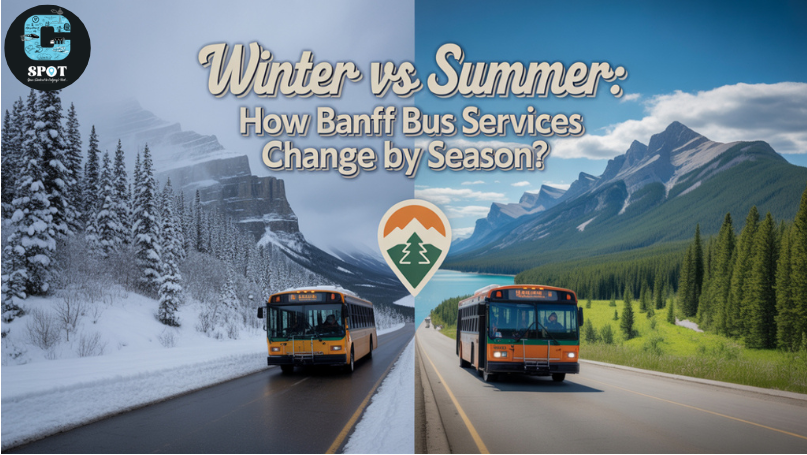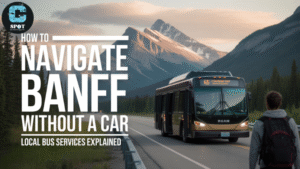Banff is one of those places that never looks the same twice. Whether it’s blanketed in snow or glowing under the summer sun, every season transforms the entire landscape. What most travelers don’t realize, though, is that Banff Bus Services change just as dramatically.
From route adjustments to schedule frequency, the transportation system adapts to the rhythm of the seasons. Understanding these changes can save you time, money, and a few travel headaches, especially if it’s your first visit to this mountain paradise.
Why Seasonal Changes Matter for Banff Bus Services?
Banff is both a thriving town and a protected national park, meaning transportation here isn’t just about convenience, it’s about sustainability. The town sees two major tourist waves:
- Summer (June to September) – peak hiking, sightseeing, and adventure season.
- Winter (December to March) – the ski and snowboarding months, attracting a completely different crowd.
Each season has unique travel demands, weather conditions, and visitor behavior. To balance this, Banff Bus Services modify their routes, schedules, and even the types of buses they operate.
This ensures smoother mobility, less congestion, and a better overall experience for everyone exploring the Rockies.
Banff Bus Services in Summer: More Routes, More Freedom
Summer is when Banff truly buzzes. The town is alive with tourists heading to Lake Louise, Moraine Lake, Johnston Canyon, and other hotspots. Because of this, the summer schedule for Banff Bus Services becomes more extensive.
What to Expect During Summer:
- Frequent Departures: Buses run more often, sometimes every 15–20 minutes on busy routes.
- Extended Routes: Additional seasonal lines are introduced to reach scenic locations like Moraine Lake or Lake Minnewanka.
- Longer Operating Hours: Services often start early and continue late into the evening to accommodate sunrise and sunset seekers.
- Eco-Focused Operations: Hybrid or low-emission buses are used more frequently to handle the tourist load responsibly.
Top Summer Routes
| Route | Main Destinations Covered | Operating Hours | Frequency |
| Route 1 | Sulphur Mountain & Banff Gondola | 7 AM – 11 PM | Every 20 mins |
| Route 2 | Tunnel Mountain & Campgrounds | 6:30 AM – 10:30 PM | Every 30 mins |
| Route 6 | Lake Minnewanka | 7 AM – 8 PM | Every 40 mins |
These flexible routes make it easier for tourists to plan day trips without needing to rent a car. The focus is on accessibility and environmental sustainability, two areas where Banff Bus Services excel.
Banff Bus Services in Winter: Comfort and Reliability First
When the snow starts falling, Banff becomes a completely different experience. Skiers and snowboarders replace hikers and bikers, and the demand for transport shifts from sightseeing to ski shuttle services.
What Changes in Winter:
- Reduced Frequency: Buses run less often due to fewer visitors and shorter daylight hours.
- Specialized Routes: Ski resorts like Sunshine Village and Mount Norquay become the primary destinations.
- Heated Buses: Comfort is prioritized; buses are equipped with heating systems to make rides cozy even on freezing mornings.
- Road Safety Measures: Routes are planned considering snow conditions and ice-prone areas, ensuring safe travel.
Key Winter Routes
| Route | Main Destinations Covered | Operating Hours | Notes |
| Route 8X | Banff to Lake Louise | 6 AM – 8 PM | Connects major ski lodges |
| Route 9 | Banff to Canmore | 7 AM – 9 PM | Year-round but reduced winter schedule |
| Ski Shuttle | Sunshine Village, Norquay | Varies | Dedicated service for ski resorts |
While the schedule may be leaner, the comfort and dependability of Banff Bus Services in winter make them ideal for those not wanting to drive icy mountain roads.
Seasonal Comparison: Banff Bus Services in Winter vs Summer
Here’s a quick breakdown to help you visualize how the service changes between the two seasons:
| Feature | Summer (June–Sept) | Winter (Dec–Mar) |
| Frequency | High – Every 15–30 mins | Moderate – Every 45–60 mins |
| Operating Hours | Early morning to late night | Daylight hours only |
| Routes Available | Extensive – Lakes, trails, attractions | Limited – Ski resorts and main roads |
| Passenger Type | Sightseers, hikers, families | Skiers, snowboarders, locals |
| Bus Type | Standard & eco-friendly | Heated, winter-ready models |
| Traffic Levels | Heavy tourist flow | Moderate with weather delays |
Insider Tips for Using Banff Bus Services in Any Season
Whether you’re coming for the snow or the sun, a few smart travel moves can make your bus experience smoother:
- Check Real-Time Schedules: Download the official transit app or check live updates before heading out, as timings can shift with weather changes.
- Buy Passes in Advance: Multi-day or unlimited ride passes save both time and money, especially during summer.
- Avoid Peak Hours: Early morning and late evening rides are often less crowded, giving you more space and peace.
- Pack for the Weather: Even in summer, Banff can surprise you with sudden rain or cool winds. In winter, always dress in layers.
- Opt for Contactless Payment: Most Banff Bus Services now support tap cards or mobile wallets for quick entry.
- Plan Transfers Carefully: Some routes require switching lines, especially if you’re traveling from Banff to Lake Louise.
These small details can make a huge difference between a rushed, uncomfortable trip and a relaxed, memorable one.
The Environmental Impact of Banff Bus Services
Banff is known for its pristine landscapes, so sustainability plays a big role in how the local bus network operates. Choosing Banff Bus Services over private cars or taxis significantly reduces emissions and traffic within the park.
- Public buses are designed with eco-friendly engines.
- Seasonal routes reduce congestion in sensitive wildlife areas.
- Encouraging group travel supports Parks Canada’s conservation goals.
So, besides being practical, using the bus system contributes directly to preserving Banff’s natural charm.
When Should You Choose Each?
If you’re still debating when to visit or which season suits your travel style, here’s a quick guide:
- Choose Summer if you want to explore lakes, hiking trails, and attractions with frequent routes and longer days.
- Choose Winter if you’re here for skiing, snowboarding, or a quiet, scenic experience with cozier, less crowded buses.
Each version of Banff Bus Services has its own rhythm. It really comes down to what kind of Banff you want to see.
Final Thoughts
Banff transforms beautifully from season to season, and so does its transportation. The summer network of Banff Bus Services thrives on flexibility and reach, while the winter system focuses on comfort and dependability. Both are thoughtfully designed to match the needs of travelers and protect the fragile mountain environment.
Whether you’re heading to the slopes or hiking trails, using Banff’s organized, sustainable bus network ensures your journey is as breathtaking as the destination itself.





